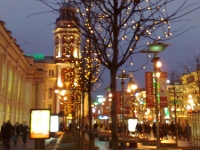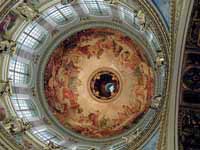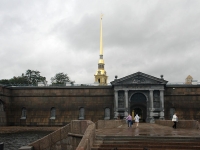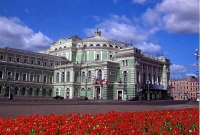Situated on the Gulf of Finland and spread over numerous islands in the Neva Delta, St Petersburg is a city of arched bridges, winding canals, wide boulevards, elegant palaces, impressive squares and ornate churches, and as such is often referred to as the 'Venice of the North'. It has an elegance also reminiscent of cities like Paris, Berlin and Amsterdam, but is at the same time too Russian to be European, and beguiles with a charm of its own.
It is the country's most beloved and beautiful city, founded by Peter the Great in 1703. It became the original capital of Tsarist Russia, and the greatest artists, sculptors and architects worked together to create the city's unique look. Rich aristocratic palaces and government buildings line the streets, along with majestic cathedrals and elaborate churches, from the golden spires of St Peter and Paul Cathedral, the magnificent gleaming dome and grand colonnaded façade of St Isaac's, to the colourful multi-domed Church of the Resurrection.
Although the Russian capital moved to Moscow after the Revolution, the city remains the principal artistic and cultural centre of the country. St Petersburg is the birthplace of Russian ballet and performances by the Kirov Ballet, rivalling the Bolshoi ballet in Moscow, are shown in the historic Mariinsky Theatre. The magnificent green and white Winter Palace forms part of the Hermitage Museum, one of the world's greatest art galleries, and the city's foremost attraction.
With its romantic waterways and decorative tsarist architecture, St Petersburg is also the perfect setting for the famous 'White Nights', and the summer months of June and July are crowded with visitors who come to experience the dreamy twilight that takes the place of night, an occurrence due to its northerly latitude when the sun never dips far enough below the horizon to create total darkness, along with music festivals and cultural events.
Attractions
Almost three miles (five km) long, Nevsky Prospekt is one of the best-known streets in Russia and is the main thoroughfare of St Petersburg, starting at the Admiralty whose gilded spire is a famous city landmark, to the Moscow Railway Station and then to the Alexandr Nevsky Monastery where some of the country's most celebrated artistic figures are buried. It has been the hub of the city for centuries, cutting through the most historical part, and home to the most important sights in the city. Intersected by rivers and canals, the most beautiful part of the avenue surrounds the Griboedova Canal. Here the impressive colonnade of the grand Kazan Cathedral catches the eye, curving around a small grassy square, and opposite the view along the canal towards the multi-coloured onion domes of the Church of Our Saviour on the Spilled Blood (officially called the Resurrection of Christ Church) is breathtaking. Modelled on St Basil's Cathedral in Moscow and adorned with exquisite mosaic panels the church is one of St Petersburg's most striking landmarks, built on the site of the assassination of Emperor Alexander II in 1881. As well as many churches the street boasts St Petersburg's finest shops and restaurants, old manors and impressive buildings, and a beautiful mixture of architectural styles from the different periods of its history.
| |  |
The golden dome of St Isaac's Cathedral dominates the skyline of St Petersburg, the colonnade around the cupola offering superb panoramic views over the city. It was commissioned by Tsar Alexander I to be a magnificent imperial cathedral, and the ensuing masterpiece was of grandiose proportions that took over 40 years to build and was decorated in the most extravagant manner. The Russian Classic style exterior encloses a splendid interior adorned with red granite columns, exquisite mosaics, painted ceilings, sculptures, frescoes, and a beautiful stained glass window, incorporating many different kinds of stone and marble work into the massive structure. The cathedral can accommodate 14,000 worshippers, but today services are only held here on special occasions. It is worth noting that no photgraphy or filming is allowed in either the Cathedral or the Colonnade.
| |  |
Situated on a small island on the Neva Delta across the river from The Hermitage, the Peter and Paul Fortress is the oldest building in St Petersburg. Planned by Peter the Great as a defence against possible attacks from the Swedes, the fortress never served its original purpose as they were defeated before its completion, and the six bastions at its corners were turned into high security political prison cells. The notorious dungeons held many famous people, including Alexei, the son of Peter the Great, Trotsky and Gorky, and it is now a museum. Other buildings in the fortress house the City History Museum and the Mint. The midday gun is fired every day from the roof, echoing around the city from across the water. Also enclosed within the imposing walls is the Cathedral of St Peter and St Paul, its distinctive golden needle-like spire visible throughout the city. The first church in the city to be built from stone, it has a richly decorated interior containing the tombs of every Russian Emperor since Peter the Great.
| |  |
| The Winter Palace and the Hermitage Museum |
The magnificent green, white and gold Winter Palace is superbly situated on the banks of the Neva River, a 656 ft-long (200m) Russian Baroque building that is the biggest and most lavishly decorated palace in the city. The palace was the official residence of the tsars, and Catherine the Great later added the Small and Large Hermitages onto the palace as a sanctuary for herself and her private art collection. The Hermitage Museum comprises a stately complex of buildings strung along the embankment, with the Winter Palace at its heart. The Hermitage Museum is one of the world's greatest art museums that has grown from a small collection of paintings started by Catherine the Great in 1764, to a massive display of over three million exhibits, housed within the sumptuous splendour of one of the most luxurious palaces worldwide. The three floors cover a full range of world art from ancient times, to Russian works and 20th century Europe, and a fabulous collection of Impressionist and Post-Impressionist paintings, set against the rich interior of white marble staircases, golden ceilings, crystal chandeliers, and elaborate mosaics. Of the highlights, the lavish State Rooms, the Golden Rooms, containing a spectacular collection of royal jewels, gold and silver, and the modern European art section are the most popular.
| |  |
The main square of St Petersburg and one of the world's most magnificent plazas, Palace Square contains the picturesque Baroque buildings of the Winter Palace and Hermitage Museum on one side and the Classical yellow and white former General Staff buildings of the Russian army on the other. The focal point of the square is the Alexander Column, a tall monolith of red granite topped by the statue of an angel and a cross, dedicated to Russian military victory in the Napoleonic wars. Palace Square has been the site of numerous political protests, most notably the demonstrations of Bloody Sunday in 1905 that started the first Russian Revolution. Today the square, with its beautiful views of the Admiralty's golden spire and the dome of St Isaac's Cathedral from across the vast stone paving, is filled with markets, outdoor cafes and the sound of horse-drawn carriages.
| | 
|
Events
| Stars of the White Nights Festival |
St Petersburg - Mariinsky Theatre and Philharmonic Hall
This festival of performing arts is the essence of the Mariinsky theatre's artistic achievements, home of the celebrated Kirov Opera and Ballet, and is a must for ballet, opera and classical music lovers. The annual White Nights Festival derives its name from the short summer season when the sun never sets, and the beauty of these white nights contributes to the festival's special atmosphere and its world-class programme of concerts, as audiences exit the historic theatre at midnight into daylight to stroll home through the theatrical setting of St Petersburg. The festival presents the company's most exceptional productions with performances by leading Russian and international artists, and combines famous historical productions along with new premieres and contemporary pieces.
| |  |






No comments:
Post a Comment